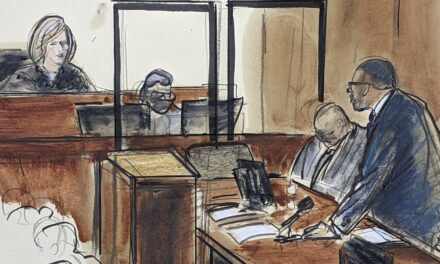
Biden in Europe: Live Updates of President’s First Overseas Trip

President Biden, in his first trip abroad since taking office, arrives in Europe today with a daunting agenda: Reassure allies that the hostility of the Trump years was a momentary aberration in U.S. policy, coax them toward coordinated policies on Russia, China, global warming and the coronavirus, and then confront Vladimir V. Putin of Russia.
It would be a formidable set of challenges in the easiest of times. These are not those times.
Mr. Biden is fighting to pursue his domestic agenda, including a trillion-dollar infrastructure spending plan, with razor-thin Democratic control of Congress and determined Republican opposition. The United States is well along the road to emerging from the pandemic and recession, but much of the world remains caught in their grip, and health experts warn that no country is safe from the virus until every country is.
Mr. Putin, the Russian president, who has stated that a “new Cold War” is underway, appears as determined as ever to undermine Western economies, alliances and political systems. Mr. Biden takes a much tougher rhetorical stand on Russia than his predecessor, Donald J. Trump, but the White House has limited leverage at its disposal.
An increasingly authoritarian China is flexing its muscles commercially, diplomatically and militarily, and Mr. Biden sees it as more of a long-term challenge than Russia. But it is not clear how he might corral U.S. allies into a strategy to modify China’s behavior.
Mr. Biden has made ambitious promises on climate change, but other countries are skeptical about the strength and durability of American commitment.
Hanging over the trip will be the specter of Mr. Trump, who disdained and threatened traditional alliances, abandoned international agreements, started trade wars and displayed an affinity for autocratic leaders, including Mr. Putin.
But however friendly the reception, European leaders are wary, having learned that what they once took to be immutable American policies could change suddenly.
Mr. Biden will travel tonight to Cornwall, the southwestern tip of England, where the annual summit meeting of the Group of 7 large, wealthy democracies will be held from Friday through Sunday. Beginning on Thursday, he will also hold one-on-one meetings with other G7 leaders, and on Sunday he will visit Queen Elizabeth II at Windsor Castle.
On Monday, Mr. Biden will attend the NATO summit in Brussels and have bilateral meetings with NATO heads of government, and on Tuesday, he will meet there with leaders of the European Union, many of whose member countries are also in NATO.
He will meet with Mr. Putin on Wednesday in Geneva, and then return to Washington.

Meeting over the next week with European leaders, President Biden will try to rally a Western alliance shaken by four years of President Donald J. Trump, making the case that the United States is back and ready to lead anew.
The Europeans wonder if it’s true, or if Mr. Biden represents the last gasp of an old-style, internationalist American foreign policy.
As president, Mr. Trump, with his “America first” outlook and isolationist and protectionist instincts, disparaged and unwound traditional relationships and embraced autocrats like Vladimir V. Putin of Russia.
Mr. Biden arrives in Europe with considerable good will simply by not being Mr. Trump, determined to face what he calls an existential collision between democracies and autocracies. But at 78, the oldest United States president in history, he cannot escape lingering doubts about his durability or that of his policies.
The Europeans have seen that a single election can upend generations of bipartisan consensus in the United States in support of Western alliances, and now they believe it can happen again.
Mr. Biden’s overarching task is to deliver the diplomatic serenity that eluded such gatherings during the Trump years. The White House argues that stable American diplomacy is back for good, even though it can offer no guarantees beyond his tenure.
Mr. Trump has hinted at a comeback, and even if it never materializes, his grip on the Republican Party remains strong, his views popular within the party and its lawmakers within hailing distance of controlling Congress.
Just days before Mr. Biden’s trip, Republicans in Congress rejected the creation of a bipartisan commission to examine the Jan. 6 riot at the Capitol. Sitting Republican lawmakers embrace Mr. Trump’s false claims that the 2020 election was stolen. And Democrats are faltering in their efforts to pass sweeping legislation to counter Republican attacks on voting rights at the state level.
Many European leaders view events in Washington with deep unease.
“They have seen the state of the Republican Party,” said Barry Pavel, the director of the Scowcroft Center for Strategy and Security at the Atlantic Council, a Washington-based think tank. “They’ve seen Jan. 6. They know you could have another president in 2024.”

China and global warming rank high on President Biden’s list of long-range global concerns. And as he travels to Europe on Wednesday for a week of summit meetings, U.S. allies wonder if they are being asked to sign up for a China containment policy, and whether Mr. Biden can deliver on climate?
While growing more repressive at home, China is expanding its commercial, military and political reach abroad — and its greenhouse gas emissions. The Europeans largely do not see China as the kind of rising threat that Washington does, but it is an argument where the United States is making headway.
Prime Minister Boris Johnson has signed on to an effort by Washington to ensure that Huawei, the Chinese telecommunications company, does not win new contracts to install 5G cellular networks in Britain. United States officials have raised concerns that Huawei equipment could become a back door to Chinese government surveillance or control of communications.
Some in Europe are following suit, but Mr. Biden’s aides said they felt blindsided when the European Union announced an investment agreement with China days before Mr. Biden’s inauguration. It reflected fears that if the continent got sucked into the U.S.-China rivalry, European companies would suffer.
Mr. Biden is going in the other direction: Last week he signed an executive order barring Americans from investing in Chinese companies that are linked to the country’s military or that sell technology used to repress dissent inside and outside China.
For the move to be effective, though, the allies would have to join. So far, few have expressed enthusiasm for the effort.
China, which now emits more climate-heating gases than the United States, Europe and Japan combined, is key to reaching ambitious goals to fight climate change. Peter Betts, the former lead climate negotiator for Britain and the European Union, said the test for Mr. Biden was whether he could lead other nations in a successful campaign to pressure Beijing.
Four years ago, President Donald J. Trump withdrew the United States from the 2016 Paris climate agreement.
Mr. Biden is reversing that stance, pledging to cut U.S. emissions 50 percent to 52 percent below 2005 levels by the end of the decade. He also wrote in an opinion essay in The Washington Post before the summit that with the United States back at the table, countries “have an opportunity to deliver ambitious progress.”
But world leaders remained leery of the United States’ willingness to enact serious emissions legislation and deliver on financial promises to poorer countries.

The plane set to carry dozens of journalists to Europe to cover President Biden’s first trip abroad was on the runway, ready to take off.
The cicadas had other ideas.
Somehow, the flying insects had filled the plane’s engines, grounding it and forcing Mr. Biden’s aides to scramble for another way to ferry the reporters overseas. What was supposed to be a 9 p.m. departure was delayed until 11. And then until 2:15 a.m.
Perhaps it was inevitable, with billions of cicadas flying around much of the eastern United States in recent weeks. In the nation’s capital, where a brood that emerges every 17 years is near its beastly peak, they have crawled up the necks of TV journalists, splattered across car windshields and gotten tangled in the hair of anyone braving the swampy, 90-degree heat.
White House travel officials delivered news of the insect malfunction to reporters gathered at the airport hotel, along with assurances that a new plane was headed to Washington from New York. A new pilot in Cleveland was soon to be en route — and both, officials hoped, would make it safely through the cicada cloud, which has been dense enough around Washington to be picked up on weather radar.
Before he left for Europe on Wednesday morning, President Biden had his own encounter with a cicada: He brushed one off his neck as he headed to the airport.
“Watch out for cicadas,” he reminded reporters before boarding Air Force One.


























